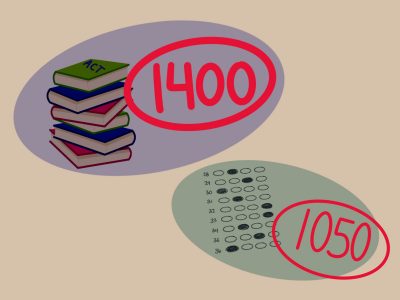1600 SAT, 36 ACT — they’re the perfect numbers that appear so easily on paper, but are a part of a larger, and far more comprehensive rite of

passage for high schoolers nationwide.
For current college students, the sound of those acronyms might send a shudder down their spine — a painful flashback to sitting in a sweltering room full of crowded desks and staring into a booklet for hours on end. But as far as many admissions offices see it, taking the exam is an essential measure of college preparedness.
Perhaps this correlation between a score and intelligence is why so many students feel doubtful about their academic capabilities. All too often students are reminded by guidance counselors that a strong GPA and stellar extracurriculars are good, but are not nearly as significant in predicting success in the way an SAT score will.
In reality, no matter how many lessons high schoolers may do with Sal from Khan Academy, there is simply not enough time between school and other activities to devote ample hours into exam cramming.
After all, the key to acing a standardized test is not simply drawing on some bank of stored knowledge — it’s to teach yourself how to master the organization and process of the exam itself.
During Covid-19 pandemic many scheduled SATs were canceled. Given pressing orders to quarantine, the number of test-optional colleges doubled from 713 to an astonishing 1,350.
At the time, College Board understood that the availability of safe testing environments varied based on a student’s location, or nearness to a center that was willing to offer it — but we now wonder why that same logic of accessibility can not be applied to the other socioeconomic barriers that tip the playing field when it comes to SAT preparation and scores?
We consider the SAT or ACT to be the “great equalizer” in the academic realm because, by nature, every school has a different way of inflating, deflating, stretching, boasting and manipulating GPAs in a way that makes them impossibly comparable.
So many turn to standardized tests to bridge the divide because it’s presumed that if everyone takes the same test, then the chance to achieve the coveted 1600 or 36 should be within everyone’s reach—right?
Contrary to popular belief, this alleged neutral measure of intelligence has been contaminated by implicit class and race biases.
Data from the College Board’s 2015 exam found that students with an income of less than $20,000 scored lowest on the test, and those with an income above $200,000 scored highest — and this doesn’t come down to just a few extra points. The report indicated, for example, that students in the lower income bracket earned a 433 reading score, while those in the elevated bracket scored 570 on average.
The advantage, which is normally attributed to test preparation services and expenses, is no longer discrete. There is clear evidence that quality tutoring services do improve scores by an average of at least 90 points — the margin may be small, but any indication of leverage proves this is not an entirely fair system.
Not only that, but we have to consider the privilege of taking the SAT itself. The sticker price for a test booklet alone costs around $50. And even if you consider being your own coach, keep in mind that an individual workbook could set you back an equivalent amount.
Universities might think that by establishing an SAT and ACT score range to apply, they’re weeding out weaker applicants. But what they’re really doing is making admission so exclusive and stringent that people will go to great lengths to get a near-perfect score.
The most egregious instance was stressed by “Operation Varsity Blues.” The sting that eventually became a federal court case bore witness to the fraud and bribery committed by parents to secure their kids a substantial SAT score.
Every university should consider making score submission optional. In doing so, they not only make the application process for new students less restrictive, but it also gives them access to more options that may better suit their interests.
We acknowledge that everyone comes from a different educational background in the same way that they do social, economic and cultural — so why should every student be defined by a single number they earn from a test that isn’t holistically fair?
This article was written by Opinion Co-Editor Analise Bruno